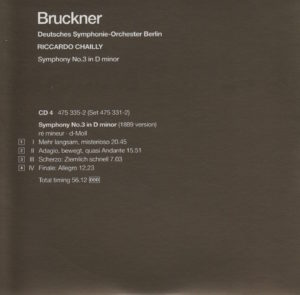 This morning’s conductor of Anton Bruckner’s Symphony No. 3 in D Minor (WAB 103), nicknamed “Wagner,” is Italian Riccardo Chailly (1953-). The orchestra is Deutsches Symphonie-Orchester Berlin.
This morning’s conductor of Anton Bruckner’s Symphony No. 3 in D Minor (WAB 103), nicknamed “Wagner,” is Italian Riccardo Chailly (1953-). The orchestra is Deutsches Symphonie-Orchester Berlin.
I first encountered Mr. Chailly on Day 2. My second encounter with Chailly occurred on Day 18.
I need to remind myself what’s going on with Symphony No. 3 in D Minor before I get too much further into this morning’s listening of it. According to its entry on Wikipedia:
Anton Bruckner’s Symphony No. 3 in D minor, WAB 103, was dedicated to Richard Wagner and is sometimes known as his “Wagner Symphony”. It was written in 1873, revised in 1877 and again in 1889.
The work has been characterised as “difficult”, and is regarded by some as Bruckner’s artistic breakthrough. According to Rudolf Kloiber, the third symphony “opens the sequence of Bruckner’s masterpieces, in which his creativity meets monumental ability of symphonic construction.” The work is notorious as the most-revised of Bruckner’s symphonies, and there exist no fewer than six versions, with three of them, the 1873 original version, the 1877-78 version, and the composer’s last thoughts of 1889, being widely performed today.
Chailly chose the 1889 version.
 In yesterday’s post, I wrote a lot about the background to Symphony No. 3 in D Minor. A lot of great stuff there (at least, I think so). Before proceeding, you may wish to review what I wrote yesterday.
In yesterday’s post, I wrote a lot about the background to Symphony No. 3 in D Minor. A lot of great stuff there (at least, I think so). Before proceeding, you may wish to review what I wrote yesterday.
It’s time to dive into the nuts and bolts of this morning’s recording:
Bruckner’s Symphony No. 3 in D Minor, composed in 1873
The version used is the 1889 version
Riccardo Chailly conducts
Deutsches Symphonie-Orchester Berlin plays
The symphony clocks in at 56:12
This was recorded in May, 1985, in Berlin, Germany
Barenboim was 33 when he conducted it
Bruckner was 49 when he composed it
This recording was released on the Decca Record Label
Bruckner wrote his symphonies in four parts. The time breakdown of this one (Symphony No. 3 in D Minor, 1889 version), from this particular conductor (Chailly) and this particular orchestra (Deutsches Symphonie-Orchester Berlin) is as follows:
Moderato (Mehr langsam, misterioso, officially)………………………….19:07
Adagio (Bewegt, quasi Andante, officially)…………………………………….15:42
Scherzo…………………………………………………………………………………………….7:22
Finale………………………………………………………………………………………………15:24
Total: 56:12
Okay. Now for the more subjective stuff…
My Rating:
Recording quality: 3
Overall musicianship: 5
CD liner notes: 3 (short essay translated into English, French, and German)
How does this make me feel: 4
This is an interesting turn of events for me.
Yesterday, I was left cold by Barenboim’s interpretation of Bruckner’s Third Symphony.
Today, I’m captivated by portions of Chailly’s interpretation, and hanging on all of it far more than I did yesterday.
Here’s what particularly grabbed me:
The First Movement (Mehr langsam, misterioso, what I’m calling Moderato).
I like the violins in these time codes:
8:44-9:29 (the slow build up)
9:38-10:20 (the slow build up)
10:29-10:55 (pizzicato)
Then, I like the grandeur and majesty of the full orchestra from 10:56-11:55.
13:47-14:40 (slow build up…to, unfortunately, nothing)
In the Scherzo (Third Movement), there’s a portion that sounds like a minuet starting at 2:23-2:45.
Overall, I liked Chailly’s interpretation of Symphony No. 3 in D Minor more than Barenboim’s. There is a bit of a harshness to the brass instruments throughout. But that may be due to the method in which this was recorded. Whenever I see DDD signifying an all-digital recording (Digitally Recording, Digitally Mastered, on a Digital medium) I cringe. That much digital seems to create a harshness in the recording – at least to my ears.
Bottom line: I like this recording.
Your mileage may vary.
